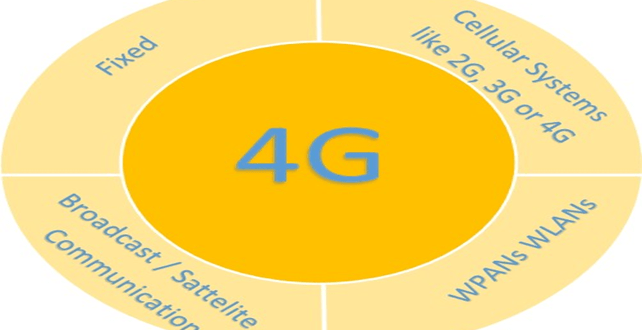Wireless communication plays a crucial role in the modern communication era. To meet the futuristic demand for artificial intelligence & real-time mapping of human beings and machines it is always necessary to improve the current communication technologies. In line with this move wireless technologies like 4G, LTE, and 5G can be deployed along with new trends in the architecture or at the protocol level. This paper proposes an analysis report of a comparison of recent wireless communication technologies. It includes the various aspects such as architecture layered views, protocols, etc proposed in recent research work by well-known scientists & authors.
The most vibrant technological area in the communication field is wireless communication and it is the fastest growing too. Wireless communication is the method of transmitting data from one point to another where we are not making use of wires, or cables. The major challenges that we should focus on are IP Spoofing, User Id theft, Denial of service, Intrusion attacks, and better quality of service beyond LTE. The advancement of Wi-Fi technology also led to the first commercial piloting of spread spectrum, high-speed optical communications, OFDM, MIMO, and mm-Wave pulse transmission technologies, these technologies became more frequently approved by cellular phone and wireless sensor networking industries. A new pattern of wireless communication, the sixth-generation (6G) system, with the full support of artificial intelligence, is estimated to be executed between 2027 and 2030. The 6G ecosystem will feature a varied range of frequency bands, extending from below 6 GHz up to 1 THz.
The present article focuses on the evolution of wireless technologies from 1G to 6G. it also deals with the challenges in LTE. It also emphasizes the encounters the designer needs to approach while designing a
4G system. It focuses on the developments and emerging trends in 5G. An exhaustive review of the research happening in 6G is also explained in the present article.
I. INTRODUCTION TO WIRELESS TECHNOLOGIES
The exchange of data takes place in wireless technologies using radio waves without an electrical conductor. Three different standards for different wireless communication are Bluetooth, DECT, and WiMAX. The word wireless communication refers to the transmission of data using electromagnetic (EM) or acoustic waves over the atmosphere rather than using any propagation medium that employs wires.

Figure: Traffic volume versus a year
In 1894 Guglielmo Marconi started to develop the wireless telegraph system with the use of radio waves. The evolution of wireless technology has happened from 1G to 5 G where 5 G is exponentially quicker compared to the previous generations. The foundation for the design of wireless communication depends on a good understanding of wireless channels.
Fifth-generation communications when matched to fourth-generation communications have improved features and we expect that to be deployed worldwide shortly. We expect 6G to be executed between 2027 and 2030 with the full support of artificial intelligence. 5G communication systems offer noteworthy
developments over the current systems, still they are not able to accomplish the demands of upcoming developing intelligent and automation systems after ten years. In this article, we draft the probable necessities and present an outline of the modern study on the promising methods developing to 6G, which have lately attracted significant responsiveness. In addition to that we have also focussed on the technical challenges as well as potential solutions associated with 6G.
Major Countries like China, India, Japan, and Singapore are researching the 6G or sixth generation which is under development. The dream of our approaching future is a networked society with abundant access of data and sharing of data which will be accessible to everyone and everywhere
The remainder of the paper is organized accordingly.
In section II, we present the evolution of wireless technologies i.e. from 1G to 4G. In section III, we discuss technologies beyond 4G. Section VI comprises a comparative analysis of 4G, LTE 5G, and 6G. The paper is concluded in section V.
- EVOLUTION OF WIRELESS TECHNOLOGIES

Figure: Evolution of wireless technologies
Communication engineering changed the thinking of reality & virtuality dramatically in the last century. Major impacts of advanced communication technologies are majorly considered after the evaluation of 3G
architecture & other advanced phases. This growth incorporates the research & development at various stages & appropriate impact is discussed one by one in the upcoming subsections.
A. FIRST GENERATION (1G):
In the late 1970’s the first major acceptable analog architecture of 1 G for mobile communication, was deployed by Nippon in Japan. In order to expand the coverage capacity for a certain geographical region, cell splitting is the preferable methodology where a base station is established to communicate through various modulation technologies proposed by researchers for voice calls. Leading communication industries developed 1G-based communication systems such as Advanced Mobile Phone System (AMPS), Nordic Mobile Phone System (NMTS), Total Access Communication System (TACS), and European Total Access Communication System (ETACS). Some of the key attributes in 1G technology are aligned with analog switching mechanisms, frequency modulation techniques (FM), and frequency division multiple access (FDMA).
In the case of circuit switching the end devices communicate by establishing a connection, then data is communicated over a dedicated path, and lastly, when the connection ends the path is made accessible for other communication. What we mean by a dedicated path is that all voice traffic will follow only this path. There are probabilities of jamming only at the time of establishing a connection. For the entire session, usable bandwidth is fixed. The main Drawback of 1G technology is that it makes use of analog signals rather than digital signals. Analog signals are more prone to Interference problems. This is a less effective means of conveying data. 2G and 3G are far more widespread when compared to 1G and the same is significantly slower.

Figure: Standardizations of technologies
Some of the major challenges for migrating from 1G are noted below:
- poor voice
- phone size
- Battery life is
- Security issues.
- It makes use of mobile phones with analog signals which have interference problems.
- Capacity is limited.
- Handoff reliability is
- Speed is very
- There was more burden on the mobile switching center as there was no mobile-assisted
B. SECOND GENERATION (2G)
Finland was the country to launch the first 2G network. A new digital technology is known as GSM is presented in the second generation. 14.4 to 64KBPS supported by GSM is adequate for SMS and Email services. In the mid-1990s qual comm presented and employed Code Division Multiple Access. CDMA has more features when compared to GSM in terms of spectral efficiency, Number of users, and data rate. The important features of GSM systems are that they have a digital system, SMS services, roaming, and enhanced security is possible. Security against Eavesdropping is achieved as Data and voice signals are digitally encrypted in 2G. Less battery power is consumed by digital signals. An intermediate technology 2.5G is introduced between 2G and 3G where we have added a packet switching technique.2G + Gprs technology is 2.5G which supports web browsing, email services & fast Upload/Download Speed.
The primary advantages of 2G networks, when compared with their predecessors, were :
- Cannot ensure digitally encrypted phone conversations in the rest of the network but at least between mobile phones and cellular base stations.
- Data services for mobile, starting with SMS text messages.
The major Challenges in Migration from 2G are as follows:
- The encryption used between the tower and the device is so vulnerable that it can be cracked in real-time by an attacker and he can intercept calls or text messages easily. This can be done passively without ever transferring a single packet.
- Another problem associated with 2G is that there is no validation of the tower to the phone. This means that anyone can effortlessly impersonate a real 2G tower and it will not be wise to use a phone with 2G protocol.
C. THIRD-GENERATION (3G)
For testing purposes, NTTDocomo introduced 3G in Japan and branded it as FOMA. When compared to 2G, the speed of 3G was about 4 times faster. The technologies 3G depend on CDMA 2000 and edge technologies.3G operates on packet switching transmission instead of circuit switching. Data is divided into small packets in 3G, and the packets are sent to the destination. In 2G the data was sent over a single channel in series whereas in 3G data can be sent over multiple channels. W-CDMA which provides better transmission speeds is being used in 3G. With W-CDMA tasks like downloading videos, doing video calls, and sharing photos can be done more efficiently.
The principal goal for the development of the third-generation network system is especially to offer greater speed in practice to the subscribers and also a provision of multimedia activities. According to International Telecommunication Union (ITU), a 3G network was defined as a wireless network that is capable of high speed in data transmission, extending from 144kbps to greater than 2mbps
3G wireless technologies can unify Existing Cellular standards, such as CDMA, GSM, and TDMA under the same umbrella. This result was accomplished with the help of three interfaces-wideband CDMA, CDMA-2000, and universal wireless communication. W-CDMA needs a bandwidth of between 5 MHz and 10 MHz, making it an appropriate platform for advanced capacity applications. It can be overlaid onto existing GSM, TDMA (IS-36), and IS95 networks. Subscribers are likely to access 3G wireless services initially via dual-band terminal devices.
In 3G the downloading time for downloading an app is around 1 minute. 3G Model handsets demand additional power and are more costly when compared to 2G models. Lots of improvements were done in 3G and a new technology named 3.5G or HSPA was introduced. HSPA+ or evolved high-speed packet access was another improvement made in 3.5G. In HSPA+ several modulation techniques like BPSK, QPSK, and 16 QAM were introduced. By using the MIMO concept capacity improvement was brought into the scenario. The error probability improved by using multiple antennas as a diversity mechanism. Expensive phones and trained personnel required for infrastructure setup are some of the major drawbacks of 3G.
D. FOURTH GENERATION (4G):
To meet the needs of future high-performance applications like multimedia, full motion video, and wireless teleconferencing 3G is not sufficient.4G is the fourth-generation technology with the advantages of greater speed and a download speed of 14 Mbps. 4G technology makes use of orthogonal frequency multiplexing, ultra-wide radio, and millimeter waves. 4G is appropriate for applications where real interaction is required because of its lower latency. Installation of 4G can be done within a matter of hours. Comparatively, 4G is much cheaper than 3G as they don’t have to retool the required operators. In addition to that, we don’t have to purchase costly extra spectrum. 4G is spectrally efficient too in addition to being cost-efficient. Scalability is the most puzzling aspect of mobile networks. Scalability is the ability to handle an increasing number of users and services. In the meantime, an all-IP core layer of 4G is easily scalable, it is preferably appropriate to encounter this challenge.
4G wireless technology is also referred to by “MAGIC” which stands for Mobile multimedia, Any-where, Global mobility solutions over integrated wireless and Customized Service
The major Challenges in Migration from 4G are as follows:
- The use of batteries is more.
- Implementation is hard.
- Complicated hardware is needed.
- The equipment needed for a next-generation network is still very
- The network has complex problems and security issues.
- 4G services are not available in the main areas yet.
- Access can be challenging for international travel.
- Users may experience poorer battery life when compared with 3G as 4G mobile networks use multiple antennas and transmitters. 4G may have to use larger mobile devices with more battery power to stay online for larger periods.
III. CONTEMPORARY 4G+ TECHNOLOGIES
- LONG TERM EVOLUTION (LTE) STANDARD
LTE is a fourth-generation wireless standard that is established to deliver better network capacity and speed for mobile devices when matched with 3G technologies. A faster version of 4G named 4G LTE advanced is available in many parts of the UK. Long-term evolution is built on GSM/EDGE and UMTS/HSPA network technologies. LTE which delivers an IP-based architecture provides tight network security which in turn supports multimedia services like teleconferencing and wireless internet. LTE provides a high data rate and low latency. The network architecture is designed in such a way as to support packet-switched traffic with great quality of service and seamless mobility. MIMO and OFDM are the key technologies that enable LTE advanced to achieve high data throughput rates. Some of the major advantages of LTE include high throughput, low latency, FDD and TDD in the same platform, Seamless connection, and simple architecture. Compared to 3G, 4G is five to seven times faster, where the theoretical speed offered is around 150Mbps. A 2GB HD film can be downloaded by 4G in 3 minutes 20 seconds, whereas it would take 25 minutes by the standard 3G network.
LTE advanced uses techniques such as carrier aggregation, coordinated multipoint, 8*8 MIMO, and Heterogeneous network support and relays which helped in achieving greater data rates. Standard 4G data connections use one antenna and one signal at a given time, while 4G LTE uses multiple antennas and multiple signals. Long-term evolution is built on GSM/EDGE and UMTS/HSPA network technologies. A major development of LTE Advanced is the introduction of 8*8 MIMO in DL and 4*4 MIMO in UL. LTE makes use of MIMO concepts where it combines multiple antennas on both the transmitter and receiver. Theoretically more the number of antennas the faster the speed is as the data streams travel more efficiently. Intercell interference is the main drawback related to LTE advanced which severely reduces the total system performance.
- FIFTH GENERATION TECHNOLOGIES (5G)
5G replaces 4G easily with exponential growth in the demand of the users, with an advanced access technology named Beam Division Multiple Access (BDMA) and Non- and quasi-orthogonal or Filter Bank multi-carrier (FBMC) multiple access. The theory behind BDMA is described by seeing the situation of the base station communicating with the mobile stations. 5G is a highly scalable technology that supports diverse types of deployment surroundings and was first launched by South Korea. Technology is the main difference between 5G and its older generations.
Mobile consumers are given the utmost priority in 5G. 5G develops the performance of business applications as well as other digital experiences. The amount of data transferred can be more in 5G as it uses a massive MIMO concept. To accomplish Network functionality, software rather than hardware is used in 5G. 5G non-standalone (NSA), the early generation 5G services are faster than 4G LTE. 5G technology is used in wireless body area networks where it has permitted the health care patients to be examined via connected devices more securely. 5G combined with ML-driven algorithms is used in the auto industry which provides information on traffic, accidents, and more. By the end of 2022, it is said that 5G will be deployed around the whole world. Establishing tower stations is costlier in 5G compared to other networks.
On 5G’s network, Artificial Intelligence will rapidly identify and develop treatment plans for you better than your doctor ever could. In the near time, we will be able to see robots wandering on farmer’s fields where it monitors the crop conditions and harvest grains
For the rollout of 5G to be fruitful, several technologies were incorporated. Some of them are listed below
- Millimeter wave: This is an exclusively new band of the spectrum being unwrapped up for 5G – from 6GHz up to 300GHz which offers infinitely developed speed and reliability. 5G networks applying mm-Wave could open the doors to a variety of data-heavy applications. It can deliver adequate bandwidth for the development of internet-connected devices and can open the door for other applications such as:
- Autonomous vehicles
- Telemedicine
- Traffic management
- Education
Likewise, mm-Wave could open up possibilities of augmented and virtual reality technology, which could be the future of how we interact with the web.
- Massive MIMO: One of the main enabling techniques for 5G wireless technology that stands for multiple inputs, and multiple outputs to improve better coverage providing increases in throughput and signal-to-noise ratio. One of the main enabling techniques for 5G wireless technology stands for multiple inputs, and multiple outputs to improve better coverage providing increases in throughput and signal-to-noise ratio. Basic MIMO in LTE is developed to 5G massive MIMO formats by increasing the number of antenna elements. By using 64 cross-polarised antennas the base station can be defined as a massive MIMO system.
- Small cells and beam forming: The use of higher frequencies leads to higher propagation loss. Increased signal interference is expected with the higher density of MIMO antennas. 5G aims to cultivate smaller cells that would be then assisted by high-density MIMO antennas. The smaller cell size addresses the matters around propagation loss.
- Network slicing: It can be well-defined as a network configuration that permits multiple networks to be made on top of a common physical infrastructure. Each “slice” or portion of the network can be assigned based on the precise wants of the application, use case, or customer. 5G supports network
- SIXTH GENERATION (6G)
The continuous growth of the wireless application & data-centric processes for the unknown fields of engineering & human beings opens the opportunity to enhance beyond 5G. The Institute of South Korea Electronics and Telecommunications Research has already proposed fundamental attributes in the terahertz frequency band for the new generation, which may be referred to as 6G. Similarly, Fraunhofer research institute & LG together have designed & developed the advanced 6G power amplifier to transfer data at very high speed at the Terahertz frequency band for the distance up to 100 meters with measurable power loss during data transfer. Researchers proposed six major characteristics attributes such as artificial intelligence and machine learning, spectrum bands, extreme connectivity, new network architecture, and security and trust. Nokia Bell Labs’ expectation to launch 6G commercially is by 2030.
5G-Advanced is likely to drive public and private networks initially in 2025 and will require a rethink of how networks are architected, designed, and deployed. It will provide robust support for critical network applications, whether via communication service providers (CSPs) or industry-grade private wireless networks.
6G architecture is expected to enhance at various phases as data, control & management phases. It is estimated that 6G will be launched commercially in 2030. Technology makes countless use of the distributed radio access network (RAN) and the terahertz (THz) spectrum to surge capacity, lower latency and improve spectrum sharing.
Key Network Characteristics
- Small Cell Networks: The small cell networks idea has been announced to advance the received signal quality as a consequence of throughput, energy efficiency, and spectral efficiency enhancement in cellular systems. As a result of this, small cell networks are an indispensable characteristic of the 5G and past (5GB) communication Therefore, 6G communication systems also implement this network characteristic.
- Ultra-Dense Heterogeneous Networks: Ultra-dense heterogeneous networks will be a critical characteristic of 6G communication Overall QOS is improved and the reduction of cost is accomplished with the use of Multi-tier networks consisting of heterogeneous networks.
- Radar Technology Integrated with Mobile Technologies: High-accuracy localization with communication is also one of the main characteristics of the 6G wireless communication system. Henceforth, radar systems will be incorporated with 6G networks.
Advantages of 6G:
Some of the major advantages of 6G are that it provides faster speeds, lower latency, and reliable connection when compared to 5g networks. A large number of applications that are not available with the current networks will be made available with the help of 6G networks. 6G makes use of advanced encryption technologies and artificial intelligence-based security measures which will provide more security in 6G when compared to other technologies. 6G makes use of OFDMA which helps it to connect several customers at the same time. The cost can be reduced by the reduction of software dependency. They have a vast coverage area which means we have to deploy only fewer towers to cover a large geographical area.
Key Issues for 6G Development
- Power Supply Issue: By making use of 6G we can connect upper trillions of autonomous low-power mobile devices amenable and proficiently. Presently, most smartphones can only be driven to last for one day, which restricts the blockages of mobile communication development. To solve this issue advanced energy-efficient wireless communication techniques can be The combined optimization of power supply method and wireless transmission technique grounded on the necessity of the mobile devices is a strategic method for understanding the future mobile-powered 6G network and qualifying energy independence for universal devices over specialized situations.
- Network Security Issue: Security is the main issue for 6G wireless In 6G, both the conventional physical layer security and integrated security are jointly considered. New security approaches that are relying on low complexity and high-security levels are worth more intensive study. To this end, some physical layer security techniques proposed for 5G can be extended for 6G networks, such as low-density parity check (LDPC)-based secure massive MIMO; secure mm-Wave techniques may also be suitable for UM-MIMO and THz band applications. With effective administration and execution, these physical-layer and network-layer security techniques can express a well-integrated security solution that professionally defends the confidential and secrecy information in 6G networks.
- Hardware Design Issue: Miniaturization of large high-frequency transmitters and receivers is the third major challenge. Years have been spent by Qualcomm and other companies to reduce MM wave components from the size of meter level to fingertip-sized modems and antennas. Optoelectronic integration (integrating the optical and electronic modules) is a favorable method for high-frequency communication systems, which is capable of developing the combined benefits of on-chip integration, high-speed semiconductor, and advanced antenna techniques.
- Terahertz signal: For transmission 6G will be making use of the Terahertz (THz) frequency For 6G to work in the terahertz frequency band will be a grand challenge where the wavelength is 300 µm. We can classify the THZ signal into a continuous signal and a pulsed one. Generation of pulsed THz signal is easy since it is possible to produce the signal with sensible size and complexity of the antenna/transmitter. Generating the continuous signal is difficult because it has stricter necessities regarding size and has more difficulty in designing the antenna/transmitter. 6G transmission necessitates continuous THz signal, therefore, generation of THz signal is problematic and expensive. The transmission aspect of 6G has to be low in cost to support the low-cost advantage claimed by 6G.
- Energy loss: The major issue with the THz signal is that it is a short-distance communication signal (i.e., a few meters). After traveling a short distance in the air it attenuates to zero. Energy loss of the signal is due to two reasons such as molecular absorption and spreading loss. This is a major setback for 6G because such a signal is inappropriate for 6G requirements. It is not economical to amplify a signal after every 1 meter. Research is continuing to make THz ideal for 6G.
Written By:
Ms. Malini Soman
Assistant Professor
Faculty of Engineering & Technology
SGT University




